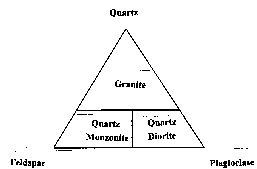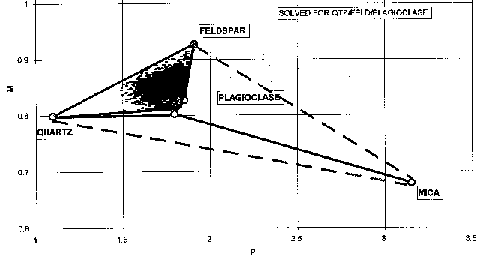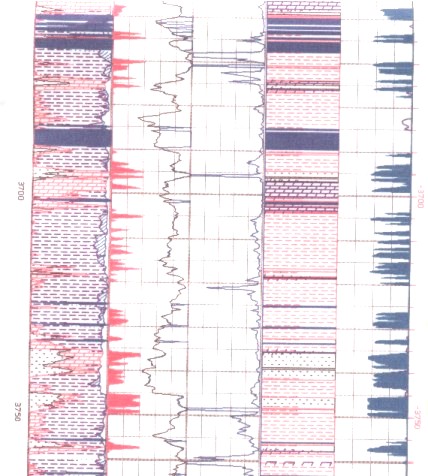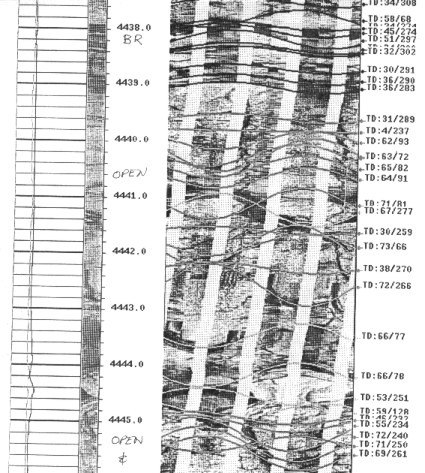|
 Granite OIL Reservoir --
FRACTURES AND POROUS
Granite OIL Reservoir --
FRACTURES AND POROUS
Most people forget that there are many unconventional reservoirs
in the world, including igneous, metamorphic, and volcanic rocks.
Granite reservoirs are prolific in Viet Nam, Libya, and Indonesia.
Lesser known granite reservoirs exist in Venezuela, United States,
Russia, and elsewhere. Indonesia is blessed with a combination
sedimentary, metamorphic, and granite reservoir with a single
gas leg. Japan boasts a variety of volcanic reservoirs.
This
example is from the Bach Ho (White Tiger) Field in Viet Nam.
Log
analysis in these reservoirs requires good geological input as
to mineralogy, oil or gas shows, and porosity. A good coring and
sample description program is essential, and production tests
are essential. The analyst often has to separate ineffective
(disconnected vugs) from effective porosity and account for fracture
porosity and permeability. All the usual mineral identification
crossplots are useful but the mineral mix may be very different
than normal reservoirs. Many such reservoirs seem to have no water
zone and most have unusual electrical properties (A, M, N), so
capillary pressure data is usually needed to calibrate water saturation.
  Ternary Diagram for Granite. Ternary Diagram for Granite.
In
the example below, the mineral assemblage was defined by the ternary
diagram at right. The three minerals (quartz, feldspar,
and plagioclase) were computed from a modified Mlith vs Nlith
model, in which PE was substituted for PHIN in the Nlith equation.
If data fell too far outside the triangle, mica was exchanged
for the quartz.
Three
rock types, granite, diorite, and monzonite, were derived from
the three minerals. A trigger was set to detect basalt intrusions.
A sample crossplot shows how the lithology model effectively separates
the minerals.

Mlith vs Plith crossplot for granite (micaceous
data excluded)
A
sample of the log analysis plot is shown below. The average porosity
from core and logs is only 0.018 (1.8%) and matrix permeability
is only 0.05 md. However, solution porosity related to fractures
can reach 17% and permeability can easily reach higher than several
Darcies. Customized formulae were devised to estimate these properties
from logs, based on core and test data. My colleague Bill Clow
devised most of the methods used on this project.


Depth plot for a granite reservoir
Note
the fracture porosity and permeability derived from open hole
log data. Fracture porosity from resistivity micro scanner logs
was also computed where available to help control the open hole
work. A black and white resistivity image log shows
some of the fractures. Both high and low angle fractures co-exist.

Resistivity micro scanner image in granite reservoir
It
is clear that non-conventional reservoirs may need some extra
effort, customized models, and unique presentations. Everything
you need to develop these techniques can be found elsewhere in this Handbook.
The mineral properties need to be chosen carefully, but the
mathematical models don't change too much.
 METAMORPHIC SAND Granite Reservoir -- Imdonesia
METAMORPHIC SAND Granite Reservoir -- Imdonesia
Here
is a granite/metamorphic example from Indonesia. In this case, the mineralogy
was triggered by quantitative sample descriptions, which in turn
were keyed to raw log response to minimize cavings and depth control
issues.

Metamorphic / Granite example with quantitative sample
description, calculates lithology, log analysis
porosity, saturation, and saturation, with core porosity and permeability
overlay. A production log cumulative productivity curve was
overlaid as well on a similar curve generated from log analysis
flow capacity (KH). Since this is a gas play, cutoffs are quite
liberal.
Quantitative
sample description of mineral composition is shown in track five
(right-hand track). Interpreted lithology is in track four; computed
porosity in track three (middle track). The log analysis porosity
matches core reasonably well (center track) and open hole fracture
indicators (right edge of track one) correspond to resistivity
image log data (left edge of track two).
|

